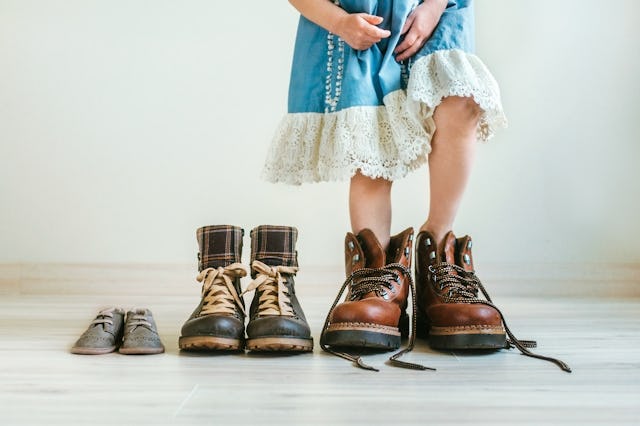When Do Kids’ Feet Stop Growing? You Might Be In For A Shocker
Real talk: Buying shoes every other week gets old fast.

For many moms, shoe-buying starts before their baby is even born. Who can resist those teeny, tiny checkered Vans? As your babe and their feet continue growing, so does the frequency of your shoe-buying — only, it spirals from bliss to an outright nightmare. You can barely get a pair of shoes on your kid's feet before they outgrow them. Sometimes it happens before your kid even gets a chance to wear them! So, you half-joke that you need to start buying stock in children's shoe companies. (They must be raking it in, right?) And by the time your little one turns 9 or 10, you're exasperatedly wondering, When do feet stop growing? Brace yourself, though. You've got a long journey ahead.
"Not-so-good for parents — it's entirely normal to be replacing your kid's shoes every few months," Dr. Wolfram Schwarz, co-founder of evidence-based medical platform Meduni, tells Scary Mommy. "Most people's feet stop growing by age 20-21, and some people report that their feet got a size or even two sizes bigger during adulthood." That's right; you're likely buying shoes for your "kid" well through college. Sure, they might start investing in their own shoe collection at some point. Still, they'll no doubt lure you into at least a few more shoe-shopping trips during and after high school.
On the bright side, those growing feet mean you're doing something right! Your kid is alive and thriving. But if buying so many pairs of shoes makes you feel like your bank account is not thriving, here are a few tips for keeping up.
When do feet grow the most?
"There are growth spurts in certain ages [when] their whole body gets bigger (not just their feet), so there could be months in which children will be one size and suddenly have to go one or two sizes up in clothes and shoes," Dr. Schwarz shares. "Even though there are standards for child growth, it's important to know that every child is different; their development and their genetics will play a key role in how much time it will take for their feet to grow to a new size. Puberty and how early in their life it hits is also a factor for how old they will be when their feet stop growing."
Seeing signs your child has entered puberty? That doesn't mean you're immediately out of the shoe-buying woods. The NHS says the average age for puberty is 11 for girls and 12 for boys. However, puberty isn't a one-and-done deal. It's a pretty long phase in your offspring's life that can last around four years. Those growth spurts will continue throughout that time and could be rather large jumps. However, as your child's growth tapers off, it's an indicator that puberty might end soon. (*fingers crossed*)
How can you make the most out of shoes for growing feet?
"As expensive as it is to be buying a new pair of shoes every six months, it's completely normal," says Schwarz. "If it's among your possibilities, having more than one pair of shoes for everyday wear could extend the life of both pairs, but in the end, you will have to replace them as they wear down."
Buying a bunch of fancy shoes that your kiddo will grow out of in a few weeks or months can feel overwhelming and just isn't in everyone's budget. The following suggestions might help you save a few bucks.
Have your child's feet measured every time.
Places like Stride Rite can help you measure your child's feet. Your kid might even be more inclined to let a stranger do it than you. Of course, you'll want to keep in mind that different brands might run slightly wider or narrower.
Hit consignment stores.
Not all shoes have to be expensive or even brand new. Granted, buying used shoes can be tricky. If the shoes you're looking at are well-worn, they probably already have a good imprint of the last kiddo's feet. This can make the transition awkward. Your best bet is to look for less-worn shoes. Don't worry; it's not as hard as it sounds — your kid isn't the only one outgrowing articles of clothing at record paces.
Alternately, if your child is obsessed with that well-loved pair of sparkly Chucks, just look for a good pair of inserts. You can often pull out the old insert and replace it instead of just sitting the new one on top.
Know that not all shoes need to be "nice" shoes.
Buy the nice Nikes or Ten Littles if you want to (and they aren’t detrimental to your budget). But as Dr. Schwarz mentions, having more than one pair of shoes will help them last longer. Save the more expensive shoes for school, hikes, or long shopping trips. Opt for some cheaper, more replaceable "play shoes" for outside.
While we're on the subject of little feet, here are a few things you should know about your tot's toes. According to a BetterHealth study, most toddlers are flat-footed in the beginning of their lives because they're still developing. So, if you want to help your child work on their balance and coordination, let them go shoeless as often as you can. And if you are ever worried about your little ones' gait, take them to the doctor or podiatrist for an expert opinion.
***If your little one has grown out of their new shoes quickly, try squeezing in one more month of wear by stretching their shoes. Take it to a shoe repair expert or fill a zip-lock bag halfway with water and place it in the shoes. Then put them in the freezer so that when the water freezes, it'll expand the shoe, giving your kid a little more room for their toes.
This article was originally published on